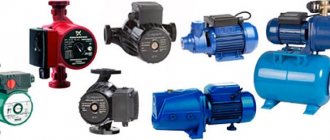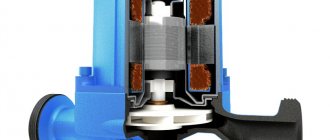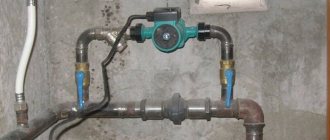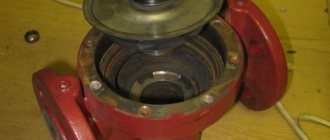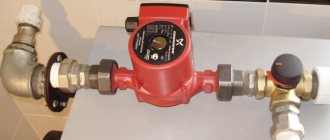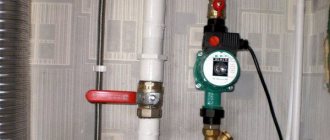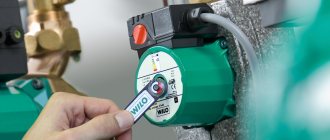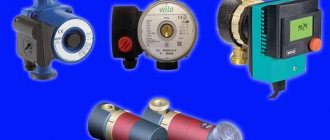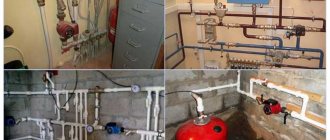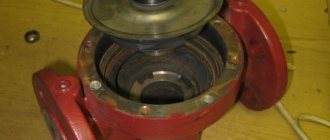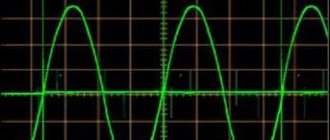Despite the widespread use of heating systems with natural coolant circulation, they have a number of serious disadvantages. These include the low speed of fluid movement, which negatively affects the final temperature in the return circuit. It should also be mentioned that not all radiators receive the same amount of hot water. Such shortcomings do not allow the house to be provided with sufficient heat.
However, today this problem can be solved if the heating system operates in combination with a circulation pump . Here the problem arises: which one to choose? If you turn to specialists, then, in their opinion, the best option among all the options offered is the Grundfos UPS pump.
Frequently asked questions about heating systems
- Is the pump pressure equal to the height of the building?
Modern heating systems are designed as hydraulically closed systems. This means that the height of the building is not taken into account when designing the pump.
When determining the pressure of heating pumps, the most important factor is the resistance of the piping system, including the resistance of its individual components, that is, fittings and bends.
- How can I remove a clogged heating pump/wet rotor pump?
Turn off the power supply to the pump. Remove the screw in the center of the nameplate. Underneath there is a shaft with a groove. After inserting a screwdriver into the groove, turn the shaft in the direction of rotation until the blockage is completely removed.
Technical characteristics overview
You can get an idea of the technical characteristics of the device using the example of one of the manufacturer’s models, which can be the Grundfos UPS 25-40ST pump . This device is in fairly high demand among owners of country houses.
If you analyze the numbers present in the marking, you can understand that the model is equipped with pipes with a diameter of 25 mm, having a pressure of 4 m. This product is capable of ensuring the efficient operation of the heating systems of a one-story house.
If the heating is presented in the form of a single-pipe system, then such a Grundfos circulation pump can successfully perform its functions in a two-story house.
Selecting a pump installation location
Opinions on this issue are completely opposite. Most are confident that the only correct solution is at the inlet of the domestic boiler, on the so-called “return” line. Although supporters of installing a circulation pump at the outlet of the unit argue that the location of the device at the supply makes heating more efficient. Who is right?
From the point of view of the laws of physics (there is such a discipline as hydraulics), this is not fundamental. In any case, the impeller will “pump” the coolant through the pump, that is, ensure the movement of liquid along a closed circuit. But taking into account the peculiarities of the operation of a domestic boiler, its “reaction” to emergency situations arising in the heating system, the circulation pump should be installed only on the “return”, that is, at the inlet of the unit.
Why? The circulation pump is designed to work with liquid media. In the event of an emergency, the coolant may boil, and steam will form at the boiler outlet, which will enter the heating system. The pump will cease to perform its function, since the impeller is not able to pump gaseous media. As a result, circulation in the circuit will stop, which will lead to an even greater increase in temperature in the heat exchanger. Next (if the automation did not work) - the boiler explodes. But if the pump is installed on the return line, then the risk that steam will “get” to it is reduced to zero.
Conclusion - from the point of view of safe operation of boiler equipment, the circulation pump should be installed only on the “return”, that is, on the pipe connected to the inlet pipe of the unit. Even if the heat generator is the latest model, with the most advanced automation, it is inappropriate to rely only on it. What if he refuses? After all, no one will argue that none of the technical means is 100% reliable.
How to choose the right pump
When choosing pumping equipment, you need to take into account the parameters of both the equipment itself and the heating circuit. If you make a mistake, the efficiency of the device will noticeably decrease, that is, money will be “thrown down the drain.”
When choosing, the following parameters should be taken into account:
- size of heated area;
- indoor temperature;
- functionality;
- temperature difference between supply and return;
- pressure;
- network characteristics;
- coolant quality.
If the choice is made correctly, taking into account all the requirements, the room will always have a comfortable temperature. When choosing power, you need to take into account the volume of the room and the indicators to which the coolant in the system should be heated. There are many calculation formulas for determining the required pump characteristics.
Carrying out calculations taking into account average indicators:
- In order to find out how productive the unit is, temperature differences are taken into account - from +30 to +35 °C. The boiler power must be divided by the resulting figure, and the result will show the consumption, that is, productivity.
- 0.6 m of pressure is enough for a pipe 10 m long. For each model, this indicator is regulated and indicated in the passport.
- Heating pipes must have the same diameter as the pipes of the connected equipment. Using one pump, up to 80 meters of circuit can be pumped.
The temperature of the pumped coolant must be taken into account. Pumps installed in heating systems operate with liquid that heats up to +110 °C.
If the circulation circuit is long and the pipes have a large cross-section, then a more powerful installation will be needed. Again, increased power is required if not water, but another, more viscous liquid is used as the coolant.
Modern pumps have a protection class of IP44. This indicates that foreign objects larger than 1 mm have entered the device and water splashes are excluded.
Recommendations for pump installation procedure
This work should be done in the so-called “off-season”. But if there is a need to carry out the installation during the heating season, the boiler needs to be “turned off” and wait until the temperature of the coolant drops - these are basic things that do not need additional comments.
- If it is necessary to install a bypass, it is better to assemble it separately, installing all the fittings and the circulation pump. All that remains is to make an insert into the pipe.
- The next stage is bleeding the air while simultaneously monitoring the system to detect leaks.
After this, you can safely switch the circuit to work with a pump.
Design features
For the manufacture of certain parts of the grundfos pump, different materials can be used: cast iron is used for the pump body, aluminum is used for the motor.
The material used for the impeller and bearings is ceramics, and for the rotor of a solid design – steel. When choosing each of these materials, their characteristics were taken into account. Thanks to them, these elements demonstrate high strength and cope well with coolant heated to high temperatures. First of all, you should highlight the bearings. Even if the pump is used in particularly harsh conditions, ceramic bearings can operate without a single repair for up to 10 years. In addition, the use of ceramics provides the advantage of reducing noise during rotor rotation.
If we evaluate the manufacturer’s assortment, it includes models of grundfos circulation pumps equipped with a technopolymer impeller and a ceramic rotor. Through the use of such innovations, it is possible to significantly increase the efficiency of the installation and extend its operational life. These features should be remembered by those for whom it is important to install a high-quality device into the heating system.
Review of other models
There are also other models on the market under the Grundfos brand:
- Magna.
- Alpha.
Magna
The model of this pumping equipment is presented in three classes: large, medium and small pumps. If we are talking about the heating system of a private house, then you should choose a device that represents the last two groups.
The model is distinguished by the fact that it is capable of equally effectively supporting the operation of the heating system, hot water supply, and air conditioning. The design includes a control unit, the function of which is to control the temperature and pressure created in the heating system. The main purpose of low-power pumps is to use them to ensure the efficient operation of heated floors.
Alpha
When developing this model, the latest achievements of the company were used, thanks to which the need to use manual and automatic adjustment methods disappeared. In other words, the company managed to create a “smart pump”. After installation, this equipment independently determines the preferred operating mode. The owner can rest assured that the device will choose the most suitable option. When using such a unit, it is possible to ensure not only efficient distribution of heat throughout the premises, but also reduce fuel and electricity costs.
During operation, the device monitors heating changes, adapting its operating mode to them. The owner has the opportunity to independently select values for certain mode parameters. For example, it is possible to provide that the pump reduces fuel consumption at night, as well as during those hours when there are no people in the house. In addition to this, the electricity supply system is equipped with a special unit, the function of which is to convert the frequency of the current.
What to pay attention to during installation?
A difficult point at the installation stage is the correct choice of the direction of the pipes.
However, there will be no problems with this due to the fact that the manufacturer has taken the necessary measures that will simplify the solution of this problem. If you look at the pump body, you can see an arrow corresponding to the rotation of the rotor. From it you can understand in which direction the coolant is moving. Please note that the circulation pump is sold without mounting hardware . Therefore, you will have to buy them separately. Having completed the installation of the circulation device, you should pause for a day, and then you can start the pump. This must be done for the reason that the operation of circulation pumping equipment must take place exclusively at positive indoor temperatures. If before purchasing the pump it was located or transported in the cold, then without natural heating of its component elements during startup there is a risk of its breakdown.
To connect the device to the AC network, it is advisable to use a separate cable separated from the distribution panel. If you use the Grundfos UPS 25-40 model, you can choose a three-core copper cable with a cross-section of one core of 0.75 mm2.
General characteristics of the Grundfos circulation pump
The company produces a wide range of units suitable for use in heating systems, hot water supply, and hot water recirculation.
Grundfos brand products work with solid fuel boilers (they have the greatest temperature differences), gas, electricity and even in projects with innovative heat sources: solar energy or a heat pump.
The advantages of Grundfos products are reliability, reliability, and versatility.
The only negative is the relatively high price of the product. The cost of one unit depends on power, configuration, performance and ranges from 5 to 70 thousand rubles. Therefore, it is important to choose the system configuration correctly. Considering the service life and reliability of the design, investments in such equipment are fully justified/
The company produces models with flange mounting and traditional screw : American. The compact design allows the installation of pumps in a wide power range with a standard mounting dimension of 180 mm . And for particularly cramped conditions, pumps of the same performance can have a reduced mounting distance of 130 mm.
The markings are standard and quite simple.
The letter index gives an idea of the specialization of the pump, followed by three groups of numbers, the first of which indicates the connection diameter, the second - the amount of pressure in decimeters, and the third - the installation length.
The main letter indices that are indicated on the devices:
- BP/BP means nut/nut fastening combination.
- BP/HP - nut/thread.
- UP - circulation.
- S - equipped with a rotor speed switch.
- D - duplex, paired.
- F - flange connection. The absence of this letter in the marking indicates a threaded connection.
- N - the body is made of stainless steel (the absence of a letter indicates a cast iron body, B - a bronze body).
- A - the housing is equipped with an air release valve.
- K - a special design that allows the use of antifreeze as a coolant.
the UPS 25–60 130 marking says that it is a circulation pump with a power (speed) switch, has a connection diameter of 25 mm , a pressure of 6 meters and a reduced landing dimension of 130 mm .
Source of the article: https://ogon.guru/otoplenie/komponenti-sistemi/nasos/grundfos.html
ALPHA2 AND ALPHA3
Now these pumps are completely identical in functionality. This happened after ALPHA2 had the opportunity to independently carry out hydraulic balancing of the heating system, which was previously only present in ALPHA3. This is a very convenient solution that has earned the informal nickname “Cure for the Cold.”
For hydraulic balancing you will need an ALPHA Reader, which is installed on the electronic unit. It must be purchased separately and is not included in the package. APLHA Reader transmits information from the pump to a smartphone or iPad. You will also need the free GRUNDFOS Go Balance application, which must be installed on your gadget. The further procedure is carried out under the guidance of the application, which will provide detailed instructions for each stage of hydraulic balancing of the entire system. The ALPHA2 and ALPHA3 pumps allow you to measure the coolant flow in any heating system (warm floor, two or single pipe systems, dead-end, radiator network without thermal heads or with a constant flow) on all radiators and underfloor heating circuits in real time. This allows you to reduce to zero possible errors, which cannot be avoided even with the most careful theoretical calculations.
However, ALPHA2 and ALPHA3 are interesting not only because of their ability to self-balance. These are modern multifunctional units that perform excellent work in different conditions. They have three fixed speed modes, three constant pressure drop modes and three proportional control modes - such a wide choice opens up the possibility of fine-tuning the system, the pump becomes universal. There are two more important additional functions: “night saving mode” and “summer mode”. In Denmark, where these pumps were developed, they are in great demand. Firstly, heating rooms that are unoccupied at night is simply irrational. Secondly, there is a question of compatibility. The pumps are suitable for use with modern boilers where a similar mode is present. Pragmatic Danes know a lot about saving; heating is generally an expensive pleasure for them. Therefore, burning gas, wood or coal in vain is an unaffordable luxury.
As for the “summer mode”, this is a seasonal function. It allows you to start heating in the fall without unnecessary problems. For example, souring of the pump shaft during a long period of inactivity. In fact, starting the system yourself several times during the summer is a real hassle. “Summer mode” will maintain the system’s functionality independently.
GRUNDFOS ALPHA2 was the first pump to feature the AUTOADAPT mode - naturally, ALPHA3 also “inherited” it. This is a new product from the company’s engineers, who pay great attention, first of all, to ease of use, and of course, energy efficiency. The function became a real breakthrough and a kind of standard for subsequent generations of circulation pumps. The AUTOADAPT mode makes it possible to automatically change equipment settings when the needs of people living in the house change, or, for example. Changes of seasons. Using complex software algorithms, the equipment electronics constantly analyzes the processes and, depending on the indicators, selects the optimal pressure. This significantly saves heating system resources and consumer money.
Now more than 3 million ALPHA series pumps are successfully operating around the world. GRUNDFOS has released an updated model, which has an even higher energy efficiency class and meets the high requirements of the European EuP standard. The average energy efficiency index (EEI) for ALPHA2 pumps is 0.15. At the moment this is the best indicator. ALPHA2 and ALPHA3 consume only 3 W in constant speed mode and 4 W in AUTOADAPT mode. This means that the pump requires 87% less energy than most analogues on the world market. They have a built-in electronic flow meter to simplify balancing and diagnostics of the heating system. They are also capable of operating at temperatures from 2 to 40 °C and even in environments that form condensation.
